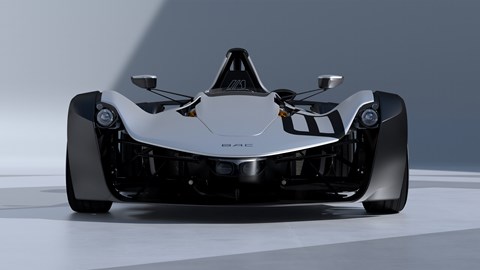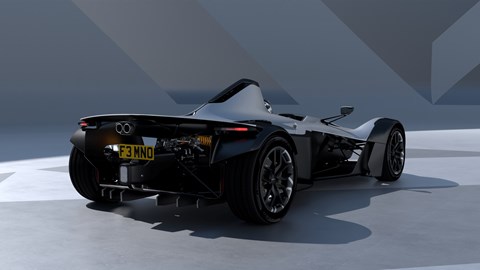► Second-generation BAC Mono makes its debut
► Powered by a stronger 2.5-litre petrol engine
► Shares the Mono R’s bodywork and cockpit tweaks
BAC has unveiled the next evolution of its Mono track weapon which, even after 12 years on sale, is still scrapping with the world’s fastest supercars. And if you think it’s identical to the previous Mono, you’re wrong – BAC’s engineers have picked their way through the entire car, changing as much as they could along the way.
The new BAC Mono is essentially a detuned version of the bombastic Mono R. That means it inherits that car’s more aerodynamic nose, larger rear wing, updated diffuser, clever graphene-infused carbon fibre body panels, revised cockpit, racing steering wheel and switchgear – and, on top of that, BAC has made a load of mechanical changes to make the car go and handle better.
We’ll start with the engine. Like the old car, it’s a naturally aspirated 2.5-litre four-cylinder unit which has been breathed on by Mountune Racing. It’s filled with exotic components, such as forged connecting rods, forged pistons, beefy camshafts, tough valve springs and a brand-new induction system with individual throttle bodies. Yes, we’re a little hot under the collar, too.

The result? A very reliable 311bhp and 231 lb ft of torque, which are stout numbers for an engine that doesn’t have forced induction. But outright horsepower figures have never been the Mono’s forte. Its strength has always been its world-beating power-to-weight ratio – and we’re happy to report that BAC’s engineers haven’t lost sight of that.
The new Mono weighs a mere 570kg, which gives it a staggering power-to-weight ratio of 546bhp per tonne. To put that into context, the 1000bhp V12 hybrid-engined Lamborghini Revuelto has a power-to-weight ratio of 564bhp per tonne – but, despite having less than half the horsepower, the Mono will be nipping at the Lambo’s heels in the 0–60mph test, taking just 2.7 seconds to finish the dash.
What other changes are there?
BAC has fiddled with the Mono’s suspension geometry, too. The company says the latest version of the car pitches 50 percent less under braking and squats 50 percent less under hard acceleration, which should make it handle more neutrally on the track. Weight distribution also plays a significant role in this predictability, as the Mono is biased 41:59 front to rear (like an F1 car).
However, if the factory setup isn’t to your liking, you can change it. The Mono’s suspension is fully adjustable, which means owners can tailor the car’s ride and handling to suit the road or the track. Buyers can even choose from a range of tyres for the car, including a specially developed Pirelli P Zero Trofeo R compound in both slick and wet tread patterns.
BAC has more plans for the updated Mono, too. Next year, the company will launch a turbocharged version of the car, powered by a tuned version of the 2.3-litre four-cylinder unit found under the bonnet of the entry-level Ford Mustang. That’ll be a game changer for the company’s European customers, as it’ll finally make the Mono Euro 6 compliant – and that means it’ll be road legal.

Neill Briggs, co-founder of BAC, said: ‘Mono is an authentic BAC supercar – it delivers the typical – yet not easily achievable – attributes that are part of the BAC DNA like high-performance, lightweight engineering, dynamic chassis, optimised suspension and an emotional design.
‘Just as importantly, Mono also creates a connection to a new type of BAC driving experience, one that can seamlessly take to the road as easily as it can encounter the demands of on-track driving,’ he added. ‘In many ways, this new supercar is a homage to the original BAC Concept that we established over a decade ago, proving its fundamental longevity.’
How much does the new BAC Mono cost?
Quite a lot. Prices start from around £215,000 – but the company justifies that expense by saying its buyers are getting a car with hypercar performance for supercar money. Indeed, during a recent track test at the Anglesey Circuit in Wales, the slightly more powerful Mono R hacked between three and five seconds off the lap times of thoroughbred hypercars such as the Ferrari SF90 and McLaren 765 LT, claiming the outright lap record for the circuit. That almost makes it look like good value.

BAC doesn’t seem worried about the price, though, because orders for the car are already flooding in. Chris Lockhart, BAC’s head of global sales, said: ‘Demand for this new supercar is unprecedented. In fact, such has been the interest, we’ve already taken orders on the Mono before its official unveiling, with the first example due to be delivered immediately following the event.’
What else has BAC been up to?
Before it launched the updated Mono, BAC dabbled with hydrogen power. The firm teamed up with Viritech in 2022 to produce a hydrogen fuel cell powered version of the Mono, which it hoped would advance the uptake of hydrogen power in sports cars. However, that plan has been put on the back burner for the time being.
When BAC built the prototype, it was concerned that tightening emissions regulations would make its cars obsolete – and it was trying to evolve to stay afloat. However, the ruling has now changed and the new emissions legislation only applies to manufacturers that produce more than 1000 cars per year. Because BAC’s production volumes can be measured in the hundreds, a spokesman for the brand told CAR magazine that BAC will keep using petrol power for the foreseeable future. Huzzah.

Still, it was an interesting project – and it presented BAC with an interesting challenge as it needed to figure out a way to retain the razor-sharp driving dynamics of the petrol Mono while dealing with the additional weight of a hydrogen fuel cell system. Hydrogen cars also require loads of computers and electronics to make them work, which was hard to package into the Mono’s tiny platform.
Neill Briggs commented on the project, saying: ‘Technology has always been at the forefront of our development, and we remain committed to exploring new automotive innovations within all that we do. Alternative fuels, along with lightweight construction methods, reduces vehicle emissions considerably without compromising driver engagement, something we are committed to preserving at BAC.’
Luke Wilkinson is a Senior Staff Writer for the Bauer Automotive Hub. He spends his time writing news, reviews and features for CAR magazine and our sister site Parkers.